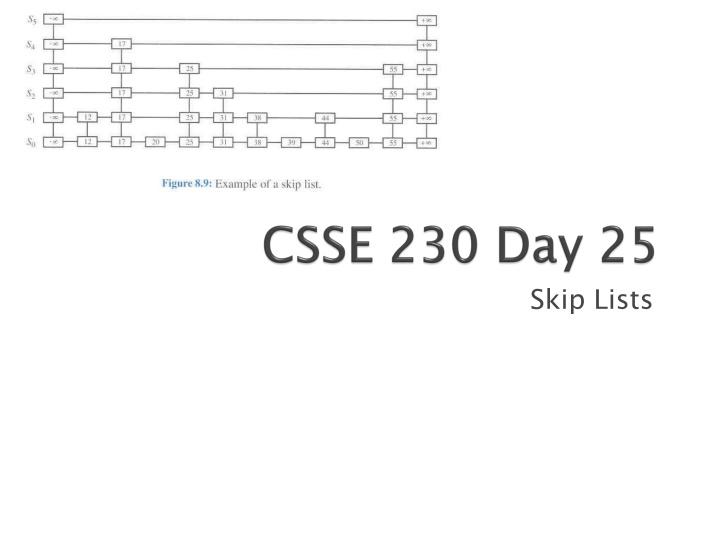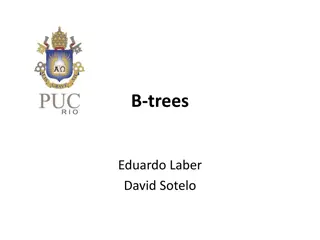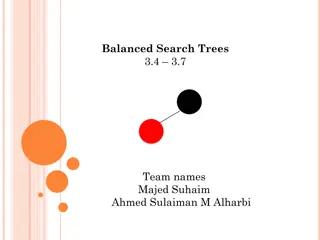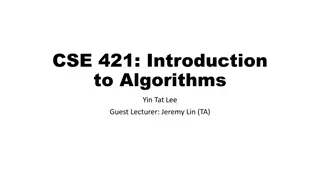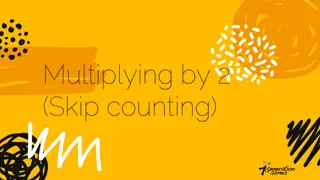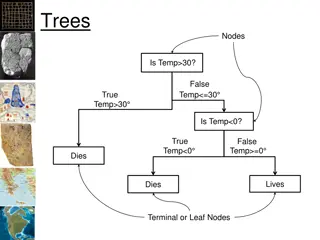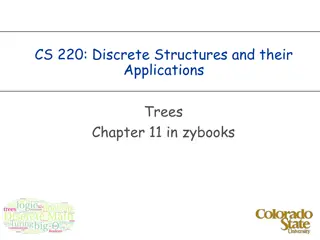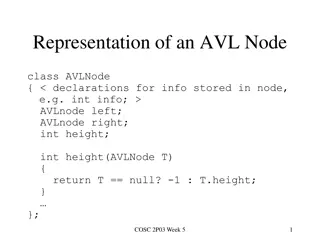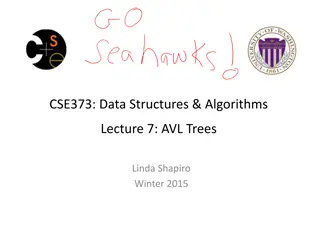Skip Lists - An Alternative to Balanced Trees
Skip lists are an alternative to balanced trees that provide expected times of O(log n) for operations. They use indexed lists with levels to address the problem of keeping trees balanced, making insertions and deletions more efficient. Despite potential O(N) behavior, skip lists offer efficient search, insert, and remove operations. This data structure, introduced by Pugh in 1990, simplifies code and offers a practical solution for managing sorted data. Skip lists allow easy iteration through lists and are beneficial for artificial intelligence applications that involve searching for solutions within a large set.
Download Presentation

Please find below an Image/Link to download the presentation.
The content on the website is provided AS IS for your information and personal use only. It may not be sold, licensed, or shared on other websites without obtaining consent from the author.If you encounter any issues during the download, it is possible that the publisher has removed the file from their server.
You are allowed to download the files provided on this website for personal or commercial use, subject to the condition that they are used lawfully. All files are the property of their respective owners.
The content on the website is provided AS IS for your information and personal use only. It may not be sold, licensed, or shared on other websites without obtaining consent from the author.
E N D
Presentation Transcript
An alternative to balanced trees Sorted data. Random. Expected times are O(log n).
Indexed lists One-level index. 2nd-level index. 3rd-level index log-n-level index. Remember the problem with keeping trees completely balanced ? Problem: insertion and deletion. Solution: Randomized node height: Skip lists. Pugh, 1990 CACM. https://people.ok.ubc.ca/ylucet/DS/SkipList.html Note that we can iterate through the list easily and in increasing order, like a threaded BST
Uses a bit more space, makes the code simpler. Michael Goodrich and Roberto Tamassia.
No guarantees that we won't get O(N) behavior. The interaction of the random number generator and the order in which things are inserted/deleted could lead to a long chain of nodes with the same height. But this is very Expected O(log n). very unlikely. Expected time for search, insert, and remove are
Given: a large set of possible solutions to a problem The search space Goal: Find all solutions (or an optimal solution) from that set Questions we ask: How do we represent the possible solutions? How do we organize the search? Can we avoid checking some obvious non- solutions? Examples: Mazes The 15 puzzle http://www.numeracysoftware.com/maze4.bmp
dead end ? dead end dead end ? start ? ? dead end dead end http://www.cis.upenn.ed u/~matuszek/cit594- 2004/Lectures/38- backtracking.ppt ? success! Note: the search is a tree and we explore it using a pre-order traversal
In how many ways can N chess queens be placed on an NxN grid, so that none of the queens can attack any other queen? I.e. there are not two queens on the same row, same column, or same diagonal. There is no "formula" for generating a solution. The famous computer scientist Niklaus Wirth described his approach to the problem in 1971: Program Development by Stepwise Refinement http://sunnyday.mit.edu/16.355/wirth- refinement.html#3 Program Development by Stepwise Refinement http://en.wikipedia.org/wiki/Queen_(chess)
In how many ways can N chess queens be placed on an NxN grid, so that none of the queens can attack any other queen? I.e. no two queens on the same row, same column, or same diagonal. Two minutes No Peeking!
1 1 Very naive approach. Perhaps stupid is a better word! There are N queens, N2 squares. For each queen, try every possible square, allowing the possibility of multiple queens in the same square. Represent each potential solution as an N-item array of pairs of integers (a row and a column for each queen). Generate all such arrays (you should be able to write code that would do this) and check to see which ones are solutions. Number of possibilities to try in the NxN case: Specific number for N=8: 281,474,976,710,656 Very naive approach. Perhaps stupid is a better word! 281,474,976,710,656
Slight improvement. squares. For each queen, try every possible square, notice that we can't have multiple queens on the same square. Slight improvement. There are N queens, N2 Represent each potential solution as an N-item array of pairs of integers (a row and a column for each queen). Generate all such arrays and check to see which ones are solutions. Number of possibilities to try in NxN case: Specific number for N=8: 178,462,987,637,760 (vs. 281,474,976,710,656) 178,462,987,637,760 (vs. 281,474,976,710,656)
Slightly better approach. columns. If two queens are in the same column, they will attack each other. Thus there must be exactly one queen per column. Represent a potential solution as an N-item array of integers. Each array position represents the queen in one column. The number stored in an array position represents the row of that column's queen. Show array for 4x4 solution. Generate all such arrays and check to see which ones are solutions. Number of possibilities to try in NxN case: Specific number for N=8: Slightly better approach. There are N queens, N 16,777,216 16,777,216
Still better approach exactly one queen per row. Still better approach There must also be Represent the data just as before, but notice that the data in the array is a set! Generate each of these and check to see which ones are solutions. How to generate? Number of possibilities to try in NxN case: Specific number for N=8: How to generate? A good thing to think about. 40,320 40,320
Backtracking solution Instead of generating all permutations of N queens and checking to see if each is a solution, we generate "partial placements" by placing one queen at a time on the board Once we have successfully placed k<N queens, we try to extend the partial solution by placing a queen in the next column. When we extend to N queens, we have a solution. Backtracking solution
Play the game: http://homepage.tinet.ie/~pdpals/8queens.htm See the solutions: http://www.dcs.ed.ac.uk/home/mlj/demos/queens (if you can figure out how to enable Java in your browser)
>java RealQueen 5 SOLUTION: 1 3 5 2 4 SOLUTION: 1 4 2 5 3 SOLUTION: 2 4 1 3 5 SOLUTION: 2 5 3 1 4 SOLUTION: 3 1 4 2 5 SOLUTION: 3 5 2 4 1 SOLUTION: 4 1 3 5 2 SOLUTION: 4 2 5 3 1 SOLUTION: 5 2 4 1 3 SOLUTION: 5 3 1 4 2 Tommorrow Tommorrow: : We'll look at details of the algorithm. Bring your computer, capabl;e of compiling and running Java programs.
